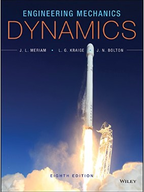The robot shown has fi ve degrees of rotational freedom.The x-y-z axes are attached to
Chapter 7, Problem 7/16(choose chapter or problem)
The robot shown has five degrees of rotational freedom. The x-y-z axes are attached to the base ring, which rotates about the z-axis at the rate \(\omega_{1}\). The arm \(O_{1} O_{2}\) rotates about the x-axis at the rate \(\omega_{2}=\dot{\theta}\). The control arm \(O_{2} A\) rotates about axis (\O_{1}-O_{2}\) at the rate \(\omega_{3}\) and about a perpendicular axis through \(O_{2}\) which is momentarily parallel to the x-axis at the rate \(\omega_{4}=\dot{\beta}\). Finally, the jaws rotate about axis \(O_{2}-A\) at the rate \(\omega_{5}\). The magnitudes of all angular rates are constant. For the configuration shown, determine the magnitude \(\omega\) of the total angular velocity of the jaws for \(\theta=60^{\circ} \text { and } \beta=45^{\circ} \text { if } \omega_{1}=2 \mathrm{rad} / \mathrm{s}, \dot{\theta}=1.5 \mathrm{rad} / \mathrm{s}\), and \(\omega_{3}=\omega_{4}=\omega_{5}=0\). Also express the angular acceleration \(\alpha\) of arm \(O_{1} O_{2}\) as a vector.
Unfortunately, we don't have that question answered yet. But you can get it answered in just 5 hours by Logging in or Becoming a subscriber.
Becoming a subscriber
Or look for another answer
